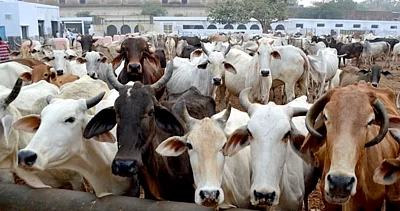In view of the outbreak of lumpy skin disease (LSD) in some districts of Haryana, Gurugram's district administration has issued orders under Section 144, banning inter-district and intra-district movement of cattle, IANS reported.
Across the country, over 7,300 cattle have died so far in eight states and a Union Territory due to the disease and vaccination drive has been stepped up to contain the infection, a senior government official told PTI.
About 74,325 cattle have been affected in Punjab so far, while 58,546 in Gujarat, 43,962 in Rajasthan, 6,385 in Jammu and Kashmir, 1,300 in Uttarakhand, 532 in Himachal Pradesh, and 260 in Andaman and Nicobar, he added.
Central teams have been dispatched to Punjab and Gujarat for taking stock of the outbreak and states have been asked to strictly implement the advisories and bio-safety measures, restriction of movement and isolation of infected animals, monitoring of stray animals, and the safe disposal of carcasses, the official told the agency.
The state governments have set up control rooms and toll free numbers and a central control room has also been established to address the concerns of state governments, the official said.
What's Lumpy Skin Disease?
Lumpy skin disease is a contagious viral disease that affects cattle. It's caused by the Neethling virus from the Poxviridae family of viruses. The virus is transmitted by insects that feed on blood, including mosquitoes, flies, and ticks.
Once infected, cows display enlarged lymph nodes and nodules on and under their skin. Infected cattle also display runny noses, fever, swelling of the legs, and can suffer permanent damage to their skin. This affects their economic value and causes tremendous losses to the owners of these cattle.
The disease, however, doesn't affect human beings.
Read more about it here.
(With inputs from IANS and PTI.)
(At The Quint, we question everything. Play an active role in shaping our journalism by becoming a member today.)
